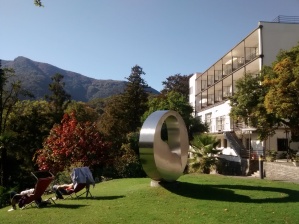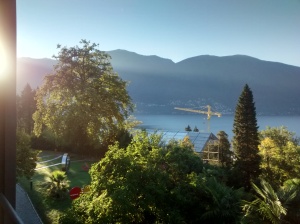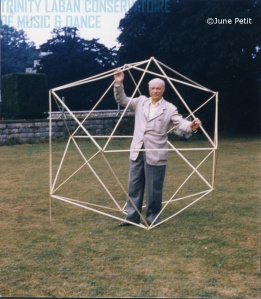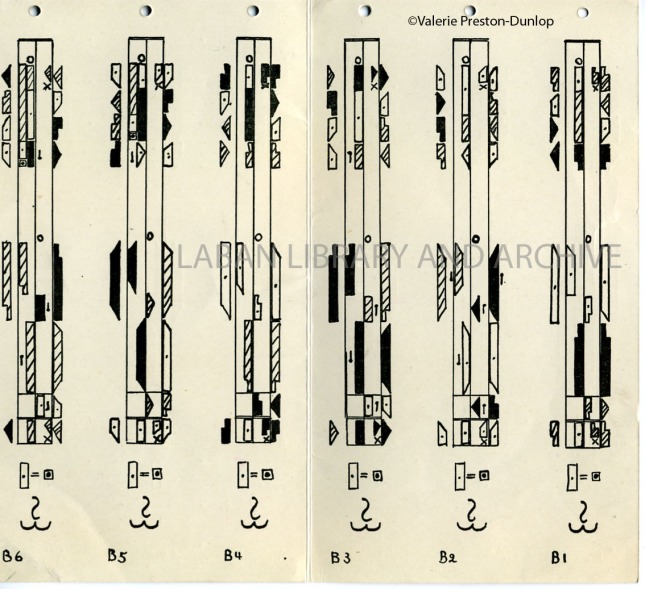Yes its ‘Explore Your Archive’ week and to celebrate we’ve been to Monte Verita, aka the ‘Mountain of Truth’ in Ascona, Switzerland to attend the Laban Event 2015. The event spanned a weekend in October and was held in the Monte Verita Hotel, built between 1927 and 1929 by the architect Emil Fahrenkamp in the Bauhaus style. The hotel overlooks the beautiful Lake Maggiore whose surrounding banks are filled with sub-tropical vegetation which thrives in the area’s Mediterranean climate.
Rudolf Laban first visited Monte Verita in May 1913 to explore the possibilities of starting a Summer School for the Arts. Monte Verita was already established as a centre for experimental living. A colony had arisen there in 1900 and nature cures, vegetarianism, psychoanalysis, anarchism and alternative approaches towards the body, sexuality and spirituality were being explored. Laban and his dancers fully arrived in June that year. They strived to live in harmony with nature by growing their own food, weaving cloth and making their own clothing. They danced outside, sometimes naked, experimenting with dynamic improvisations. It was here that Laban, with the help of Suzanne Perrottet and Mary Wigman, developed what is now called modern dance. And it was here that two of Laban’s first works, The Dancing Drumstick and Ishtar’s Journey into Hades, were created.
Laban used Schwungskalen, or swinging scales, as his basic training method for his dancers. These were large movements involving the whole body, with the directional framework provided by a body-sized octahedron or cube imagined around the mover. These scales continued to be developed by Laban into the A and B scales being sequences of twelve movements, located in the icosahedron. The Monte Verita Hotel has a sculpture of a life-size icosahedron in the grounds (see below), made by artist Miki Tallone, in an area designated as ‘Laban’s training area’.
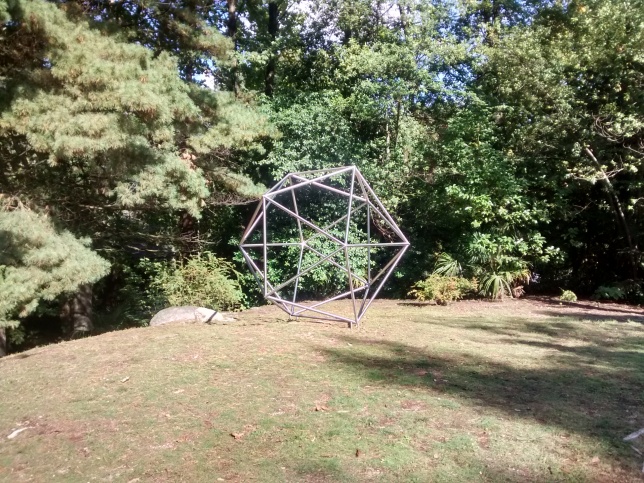 There are many photographs in the Laban Archive of dancers moving in such structures. The image below shows Rudolf Laban in an icosahedron at a summer school at Ashridge, 1955, photographed by June Petit.
There are many photographs in the Laban Archive of dancers moving in such structures. The image below shows Rudolf Laban in an icosahedron at a summer school at Ashridge, 1955, photographed by June Petit.
Rudolf Laban continued to run his summer schools, or dance farms, at Monte Verita every year until 1917. This era also saw him devote time to devising notation which was to become a major concern of his. The image below shows an example of Labanotation from the Laban Archive, written by Dr Valerie Preston-Dunlop as a ‘Thank You’ card sent out in 1949 after Rudolf Laban’s 70th birthday depicting the 12 sequences of movement representing 7 rings of similar shape.
The Laban Event was set up in 2013 to celebrate the centenary of Rudolf Laban’s first Summer School for the Arts, with an international conference at Monte Verita. A group of internationally renowned researchers was invited to share some of the guidelines that have been developed from the discoveries of Rudolf Laban. Alison Curtis-Jones, a member of the Faculty of Dance at Trinity Laban Conservatoire of Music and Dance, was commissioned by the Swiss Government to mount Suite ’24 and Nacht with Summit Dance Theatre, performed to acclaim at the Teatro San Materno, Monte Verita. The Laban Event 2014 focused on ‘dance for all’ and dealt with the theoretical and practical discourse regarding the educational and social role of dance. This included Alison Curtis-Jones presenting her current research on ‘Movement Choirs for Contemporary Audiences’, teaching master classes in her development of choreological practice for artistic and pedagogic practice and sharing her practical research on the notion of ‘community’, group cohesion and her use of proprioception to create Movement Choirs.
This year’s event, Laban Event 2015, comprised workshops, films and lectures with a common theme being the use of archives in reimagining past choreographic works. Alison Curtis-Jones led movement workshops entitled ‘From archive to production: Contemporising the past, envisioning the future’. Stefano Tomassini and Karin Hermes gave detailed presentations on the remaking and restaging of choreographic works, in particular the re-enactment of Sacre by Cristina Rizzo and the restaging of Big City by Kurt Jooss. A fascinating panel discussion took place, chaired by Dr Patrick Primavesi, Professor at the Institute for Theatre Studies at the University of Leipzig and Director of the Dance Archive Leipzig, called “Round Table on the Re” (re-productions, re-constructions, re-creations), where Valerie Preston-Dunlop told us about Laban’s first two works and how they were ‘research as practice’ in his attempt to discover the nature and rhythm of movement. On the second day of the conference, workshops on ‘Movement for actors and performers – a point of view’ were given by Maria Consagra and a Keynote presentation was given by Dr Valerie Preston-Dunlop on ‘Archeochoreology: finding a lost dance’. Valerie spoke about the need for ‘anarchic artistry in collaboration with your research’. She outlined how she had interviewed dancers who had worked with Laban and who told her that he worked by collaborating with them and that there was often live improvisation on stage – a ‘living in the moment’. (These interviews are available to be heard in the Laban Archive). She explained that Laban’s choreographic works didn’t have a fixed form – that they are open works and that the key to finding the essence of them is through creative rehearsal methods.
Valerie’s talk was complemented by sessions designed for archivists and researchers to meet and exchange information on their collections that relate to Rudolf Laban and what could be done to link them. Relevant collections are held all over the world and include:
- the Laban Archive at Trinity Laban Conservatoire of Music and Dance which holds the Laban Collection, documenting the life and work of Rudolf Laban and his associates from the 1920s to the 1950s, as well as many other collections relating to the history of Laban the institution and to the development of contemporary dance
- Tanzarchiv Leipzig e.V. has a Rudolf Laban Collection as well as others including Mary Wigman and Jenny Gertz
- Dartington Hall Trust Archive has collections which include correspondence and photographs of Rudolf Laban, Kurt Jooss and Ballets Jooss. Their catalogue is searchable online. They also have moving image clips of dance performances and open days at Dartington from the 1930s and 1940s at the Dartington Film Archive, some of which is available to view on Youtube and Vimeo.
- Special Collections, Leeds University Library holds the John Hodgson Collection which contains drawings, writings, posters, photographs and other material of Rudolf Laban. The collection can now be searched via an online catalogue and a Laban Collection guide has been written giving descriptive texts to some digitised images from the collection.
- National Resource Centre for Dance at the University of Surrey is a non-profit national archive and resource provider for dance and movement. It holds a Rudolf Laban Collection as well as other Laban-related collections. Many of their collections can be searched on their online catalogue.
- The Dance Notation Bureau holds Labanotation by Rudolf Laban and others.
- The Centre National de la Danse holds the Albrecht Knust Collection of Labanotation scores and other papers. Some of these have been digitised and are searchable online.
- Deutsches Tanzarchiv Koln holds collections of Harald Kreutzberg, Mary Wigman and Kurt Jooss and many other Laban-influenced artists.
- The Bedford Physical Education Archive at the University of Bedfordshire holds archive material bequeathed by former members of staff and students of Bedford Physical Training College (later the Bedford College of Physical Education and now the University of Bedfordshire) since its inception in 1903. It provides a unique insight into the early development of women’s physical education as well as the pioneering of Rudolf Laban’s ideas and methods of teaching dance.
- The Akademie Der Kunste, Berlin holds archive collections of Mary Wigman and Valeska Gert as well as many others.
The culmination of the Laban Event 2015 was a presentation directed by Alison Curtis-Jones of a brilliant reimagining of the two works Laban had first created in Monte Verita back in 1913, The Dancing Drumstick and Ishtar’s Journey into Hades, featuring Summit Dance Theatre, winners of the prestigious ‘Dance as Cultural Heritage’ award, music by Oli Newman and James Keane, costumes by Mary Fisher, consultant Valerie Preston-Dunlop and produced by Nunzi Tirelli and Giona Beltrametti. The performance took place at the Teatro del Gatto in Ascona and was rapturously received. The photograph below shows Summit Dance Theatre rehearsing Drumstick in the studio, photographed by Alison Curtis-Jones.
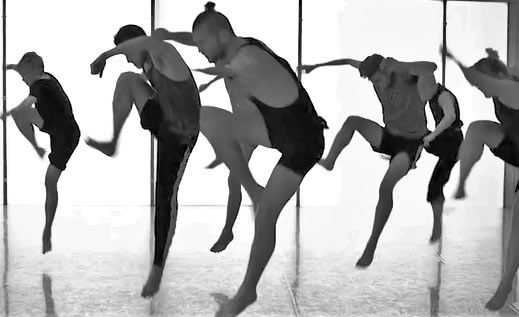 For more information about Laban Event 2015, check out their website. For information about Summit Dance Theatre, find them on Facebook. And for more information about the archives and special collections held by both faculties at Trinity Laban Conservatoire of Music and Dance, have a look at the Faculty of Dance and Faculty of Music pages.
For more information about Laban Event 2015, check out their website. For information about Summit Dance Theatre, find them on Facebook. And for more information about the archives and special collections held by both faculties at Trinity Laban Conservatoire of Music and Dance, have a look at the Faculty of Dance and Faculty of Music pages.
Explore your archives!
